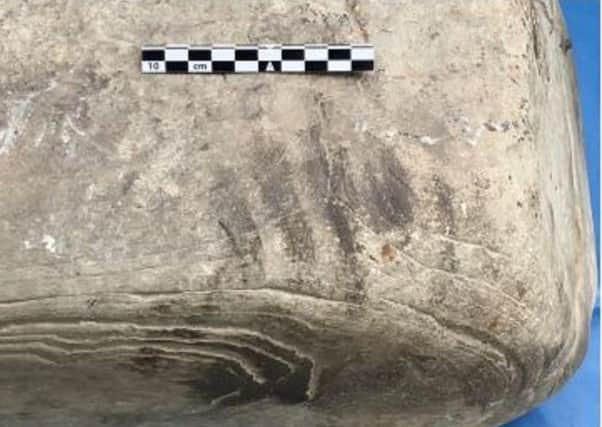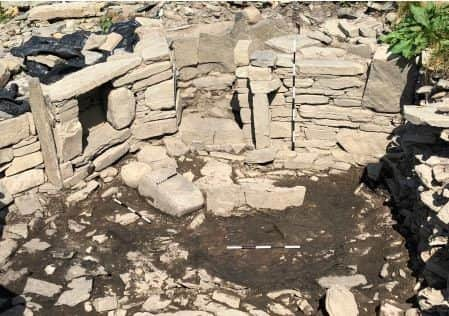Are these markings the handprint of a Pictish man?


The find was made during an excavation on the island of Rousay, where the “unparalleled remains” of a smith’s workshop from the Pictish-era have been discovered.
A large stone anvil has been removed from the site with archaeologists claiming that carbon markings found on the metal working tool are imprints from a smith’s hands and knees.


Advertisement
Hide AdDr Stephen Dockrill of the University of Bradford said analysis had confirmed that a copper smith worked in the semi-subterranean building now being excavated, with the site dating from 6th to 9th Century AD.
He added: “The analysis of the floor enables us to say with confidence where the smith worked, next to a hearth and two stone anvils.
“The biggest surprise came when we lifted the larger stone anvil and cleaned it; we could see carbon imprints of the smith’s knees and hands.”
The building being excavated was entered via steps and a curved corridor, which would have minimised the amount of light entering the smithy, Dr Dockrill added.
This allowed the smith to assess the temperature of the hot metal based on its colour.
A door would have separated the workshop from the corridor. Many of the stone fittings - the pivot stone, door jamb and bar hole - remain intact.
Advertisement
Hide AdThe centre was dominated by the hearth, with a set upright stone on the doorward side protecting the hearth fire from drafts.
The excavation project is being directed by Dr Dockrill and Dr Julie Bond, who is also from Bradford University.
Advertisement
Hide AdThe building is part of a substantial Iron Age settlement which is being destroyed by the sea.
Work this year has centred on the Pictish workshop and a Neolithic Chambered Cairn which is also being destroyed by the environment.
Orkney is known to have been part of the Pictish kingdom, with several archaeological sites linking the island to the period.
According to Orkney heritage and history site Orkneyjar, there were Orcadians at the court of the Pictish High King, Bridei, in 565 AD.
Adomnan, the biographer of St Columbus, described these Orcadians as “hostages”, which implies that relations between Orkney and Pictish King were perhaps strained, an article on Orkneyjar said.
It added: “The hostages would have been Bridei’s insurance policy to keep Orkney on a tight leash.
Advertisement
Hide Ad“Some historians, however, have pointed out that these “hostages” could have an altogether less hostile interpretation and that they were merely guests at the King’s court.”
The archaeology project is funded by the Swandro Orkney Coastal Archaeology Trust, Historic Environment Scotland, National Lottery, University of Bradford, Orkney Islands Council, Rousay Development Trust and the Orkney Archaeological Society.
